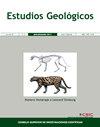Revisión de los modelos hidrogeoquímicos de génesis de tobas calcáreas
IF 0.8
4区 地球科学
Q3 GEOLOGY
引用次数: 3
Abstract
The calcareous tufa deposits in fresh waters are widely represented in the Iberian Peninsula, mostly related to springs from carbonate aquifers. Most studies on the geochemical modelling of the genesis of calcareous tufa consider the meteoric water percolating through the limestone aquifer is enriched in CO₂ by existing microbiological activity in soil. The new equilibrium with atmospheric CO₂ in springs and/or metabolic activity of microorganisms determines a rich variety of facies of calcareous tufa. The resulting water has a calcium bicarbonate nature. However, the hydrochemical modelling has not completely been addressed and the boundary conditions have not been taken into account in tufa systems in which soils present low CO₂ concentrations or when the nature of waters are Ca-Mg-SO₄-HCO₃. In this paper, hydrochemical results from two important examples of genesis of calcareous tufa are presented: Jucar river (Valdeganga - Presa de la Central Hidroelectrica del Bosque) and Guadiana Alto river (Ruidera pools). These results are also compared with other kart spring waters recently studied in the area. The water nature of Jucar river and Ruidera aquifers shows clearly a Ca-Mg-SO₄-HCO₃ facies. The hydrochemical interpretation cannot exclusively be explained using the CO₂–H₂O– calcite system, which has widely been used in studies of precipitation rates and paleoclimatic records of calcareous tufa or Karstification reactions of limestone aquifers. In this review, we evaluate the dedolomitization and gypsum dissolution, which are independent of partial pressure of CO₂, and kinetics and sustainability of processes in terms of genesis of tufa systems. We also consider other CO₂-dependent reactions such as the calcification gypsum and dissolution and precipitation of calcite by mixing waters. This explains the nature of waters from dolomite-gypsum aquifers and also their great generator potential of tufa systems, and refuses the interpretation based exclusively on the presence of humic acid-rich soils, not very common in arid and semi-arid areas. Finally, we examine mixing waters in multi-layered or compartmentalized seasonally aquifers, which can produce waters that develop calcareous tufa.石灰岩凝灰岩成因水文地球化学模型综述
淡水中的钙质凝灰岩矿床在伊比利亚半岛广泛存在,主要与碳酸盐含水层的泉水有关。钙质凝灰岩成因的地球化学模拟研究大多认为,通过石灰岩含水层渗透的大气水通过土壤中存在的微生物活动富集了CO 2。与春季大气CO₂和/或微生物代谢活动的新平衡决定了丰富多样的钙质凝灰岩相。得到的水具有碳酸钙的性质。然而,水化学模型还没有完全解决,并且在土壤具有低CO₂浓度或水的性质为Ca-Mg-SO₄-HCO₃的凝灰岩系统中没有考虑边界条件。本文介绍了两个钙质凝灰岩成因的重要实例:juar河(Valdeganga - Presa de la Central Hidroelectrica del Bosque)和Guadiana Alto河(Ruidera pools)的水化学结果。这些结果还与该地区最近研究的其他卡丁车泉水进行了比较。juar河和Ruidera含水层的水性质明显表现为Ca-Mg-SO₄-HCO₃相。水化学解释不能完全用CO₂- h₂O -方解石体系来解释,该体系已广泛用于研究降水率和钙质凝灰岩的古气候记录或石灰石含水层的岩溶反应。本文从凝灰岩体系的成因出发,对不受co2分压影响的脱白云石化和石膏溶解过程及其动力学和可持续性进行了评述。我们还考虑了其他依赖CO₂的反应,如石膏的钙化和通过混合水溶解和沉淀方解石。这解释了白云石-石膏含水层的水的性质,以及它们巨大的凝灰岩系统的产生潜力,并拒绝了完全基于富含腐植酸的土壤的存在的解释,这在干旱和半干旱地区并不常见。最后,我们研究了多层或分区季节性含水层中的混合水,这些水可以产生发育钙质凝灰岩的水。
本文章由计算机程序翻译,如有差异,请以英文原文为准。
求助全文
约1分钟内获得全文
求助全文
来源期刊

Estudios Geologicos-Madrid
GEOLOGY-
CiteScore
1.40
自引率
14.30%
发文量
6
审稿时长
>12 weeks
期刊介绍:
Since 1945 Estudios Geologicos publishes original research works, as well as reviews, about any topic on Earth Sciences.
Estudios Geologicos is published as one yearly volume, divided into two half-yearly issues. It is edited by the Spanish National Research Council (Consejo Superior de Investigaciones Científicas, CSIC) at the Instituto de Geociencias (CSIC-UCM).
Estudios Geologicos provides free access to full-text articles through this electronic edition. Accepted articles appear online as "Forthcoming articles" as soon as the galley proofs have been approved by the authors and the Editor-in-Chief. No changes can be made after online publication.
 求助内容:
求助内容: 应助结果提醒方式:
应助结果提醒方式:


